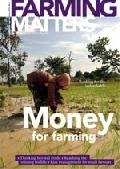Money for farming not only means access to credit, but also access to other financial products and services. Small-scale farmers can also benefit from being able to insure themselves against risk and being able to save. When it comes to money, there is a gap between what small-scale farmers need and what they have access to. But this gap can be overcome, as this issue shows.

From microcredit to microfinance
If microcredit is not the obvious answer for small farmers, then what is? We asked Janiece Greene of Women’s World Banking about the role of women in finance and farming. She highlighted the need for a broader look at smallscale farmers’ needs: “Farmers need other financial products besides access to credit. Being able to save money, for example, can help a farm family meet with unexpected drawbacks.” According to her, the “new frontier” in microfinance lies in providing possibilities for saving, especially in rural areas. This could be good news for women, as they often not only do the farming, but also the saving. “We need to think less in terms of microfinance and more in terms of financial inclusion.”
Financial inclusion – the delivery of banking services at affordable costs to low income groups – means looking beyond credit. It also involves small-scale farmers being able to insure themselves against climatic catastrophes. On page 44 of this issue Thomas Loster of the Munich Re Foundation shows how this kind of insurance can be made accessible to small-scale farmers.
Of course farmers still need credit and they have difficulties getting it. Small-scale customers are not a high priority for big financial institutions. In addition, farming is considered a risky trade, with many uncertainties – which will only increase as the effects of climate change make themselves felt. Add to this the financial crisis, which makes banks less inclined to lend money, even to businesses that are less risk prone, and one can see that small-scale farmers have a tough time financing their operations. With climate change threatening agricultural output, and a population estimated to grow by an extra 2.5 billion by 2050, even multinational food corporations are now looking towards sustainable, small-scale farmers to ensure their supplies of raw materials. If small-scale farmers are to have a role in meeting the increasing demand for food, they should also be provided with the means to do so.
The less obvious solutions
It is said that it is difficult for farmers to get credit because farming is considered a high risk activity, but there are different ways of assessing risk. In “Making farmers bankable” (page 24) Jaime ter Linden of ForeFinance moves beyond the conventional ways of assessing risk, and finds that farmers need not necessarily be considered to be a “high risk”. A different approach to risk-profiling, assessing the creditworthiness of farmers, can lead financing institutions to overcome their fear of lending to farmers.
Small-scale farming is considered a low profit activity and this also gets in the way of access to credit. Koert Jansen of the Triodos Sustainable Trade Fund shows, on page 28, that traditional financial institutions can successfully invest in small-scale, sustainable farming. He is convinced that the risk perception of financial institutions will change and that local banks will follow the approach of Triodos.
But we need not necessarily look to traditional financial institutions to adapt. As Alfred Lakwo points out in “Local resources, great capital” (page 10), if banks are not willing to provide capital to small-scale farmers, why not look at ways for the “unbankable” to come up with their own funds? He shows that there is much untapped potential in local communities.
Technology helps farmers
Yet underneath all this it is undeniable that it is expensive to provide financial services to small customers, in out-of-the-way areas with poor infrastructure. Technology is changing this. Brick and mortar structures are being replaced by “branchless banking”, bringing financial products and services within reach of people in the remotest of areas. The potential of branchless banking, made possible by the mobile phone, cannot be underestimated.
Similarly, technology also plays a role in insurance. For example the network of Safaricom, East Africa’s biggest mobile-network operator, is being used by insurance companies to collect premiums from farmers. Safaricom is from Kenya, where 27 percent of the people do not have access to banking services and only about 3 per cent of total population have any form of insurance cover, while 17 percent of the “unbanked” own a mobile phone, creating an opportunity to improve access to financial services. Regardless of technology and advances in providing small-scale farmers with credit, we can only underline Jan Douwe van der Ploeg’s point in “Thinking beyond credit” (page 36): formal credit often comes with strings attached, taking away farmers’ independence and reducing the control they have over their own resources. Credit mechanisms need to be “untied”, allowing farmers to make the choices they deem appropriate. Credit is by no means the only choice for farmers, although microcredit does offer more opportunities now, especially as it is progressing from “product-based” to “customer-based”.
Text: Petra Rooijakkers
Editorial team Farming Matters.
Photo: The future role of technology in providing farmers access to financial services cannot be underestimated. Some people believe that: “mobile banking is the future”. By: Sandipan Majumdar

